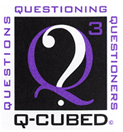As teachers begin to implement ignorance-based science lessons in their classrooms, they are often confronted with an interesting problem: how to evaluate ignorance without stifling students' creativity.
For that reason, research assistants for the Q-cubed program are developing a rubric that will help teachers assess students through an "ignorance quotient" test -- a standard some teachers are anticipating.
The rubric is a classification system with a set of rules. It can be used as a tool to evaluate questioning. During the 2002 Summer Institute on Medical Ignorance, several science teachers used the rubric in a preliminary trial to evaluate their own questioning. The rubric is still in a developmental stage, but we hope to use it in classrooms for evaluating student questioning and the effectiveness of the Summer Institute on Medical Ignorance.
Some helpful web sites that describe rubrics are listed below:
www.pgcps.pg.k12.md.us/~region2/assessment_rubrics.htm
http://search.about.com/fullsearch.htm?terms=rubrics&ch=education
www.school.discovery.com/schrockguide/assess.html
Donna Sider, a sixth-grade teacher at Baboquivari Intermediate School and a 2000 graduate of the Summer Institute on Medical Ignorance, regularly uses questioning techniques in her classroom and says she evaluates students' work based on participation only.
Art Kindler, also a 2000 graduate and a third-grade teacher, said he's eager to begin an ignorance lesson, but he's stumped on how to evaluate it. "To question everything being done is good," Kindler said. "The trouble I did have is, once you get all these questions, where do you go from there?"
Lawrence Aleamoni, head of The University of Arizona department of special education, rehabilitation and school psychology, is working with Q-cubed researchers on the Ignorance Quotient project. He said it's important for teachers to follow a universal method of evaluation. "In any learning situation, if you want to prove that actual learning is taking place, you've got to do some kind of measurement and evaluation," Aleamoni said.
Amanda Pedersen and former staff member, Stephanie Reynolds, research assistants focusing on the rubric, said they and other program staff members are working with teachers to develop a proper method.

